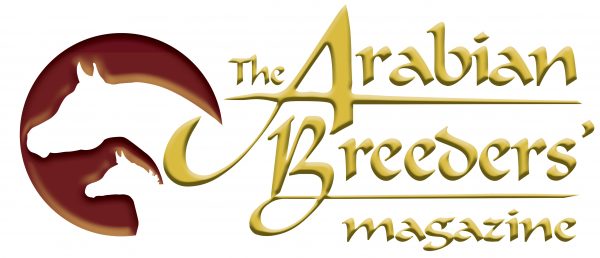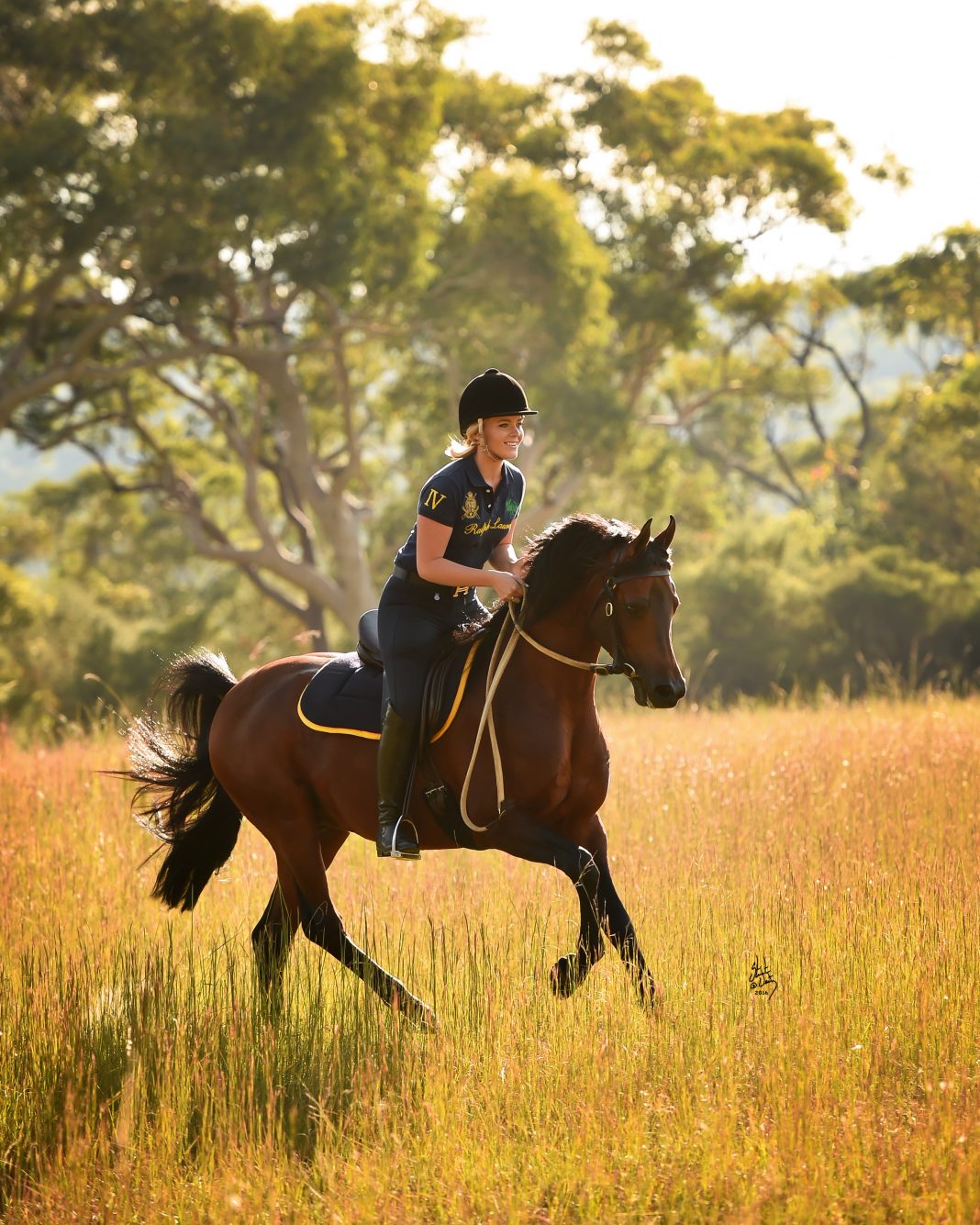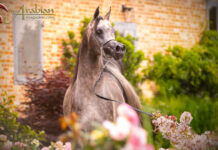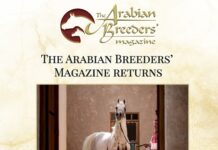First printed in The Arabian Breeders’ Magazine Volume I Issue I September 2016. Please enjoy this interview with Greg, Julie and Jane Farrell.
In every edition of The Arabian Breeders’ Magazine, we speak to a selection of breeders from around the world about their experiences and successes with their breeding programme. We are delighted to share some of these incredibly insightful features online.
The Arabian Breeders’ Magazine (TABM): Please share with our readers a short background to your farm.
Greg, Julie and Jane Farrell, Mulawa Arabian Stud: The origin of Mulawa dates back the early 1970s, with Greg’s desire to own an Arabian horse and our parents’ encouragement in the pursuit of that dream. From that initial positive experience with a purebred riding horse, the breeding programme was launched with foundation horses collected from around the world. Today, almost 50 years later, Mulawa Arabian Stud, primarily located outside Sydney, Australia, is still very much a family owned and operated business, with Greg, his wife Julie and sister, Jane, all involved with all the major aspects of breeding, promotion and daily farm activity. While the main focus of the farm is still the production of world-class Arabian horses, the Mulawa brand has expanded to include Olympic level dressage horses and warmbloods. The scope of the operation now includes five properties in two Australian states.
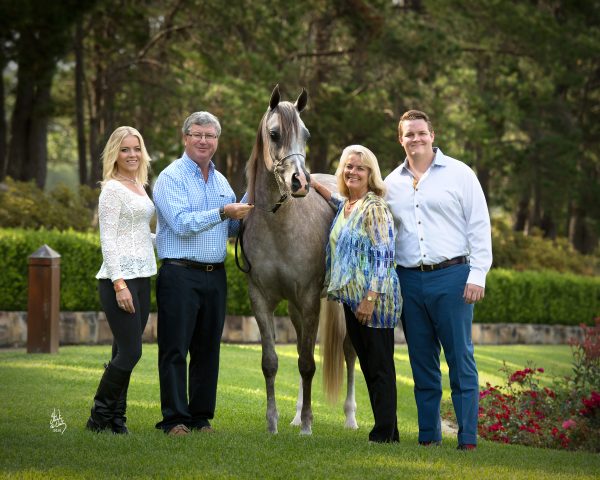
Kate, Greg, Julie and Greg Junior with Klassical Presence MI Klass x Parad.
TABM: What have been the bloodlines that you have focused on, and why did you choose them? Has this focus changed over the years?
The Farrells: The foundation stock at Mulawa was principally of Crabbet and pure Polish origin, mostly obtained from established well-respected breeders in the UK, the USA and Australia. The Polish stallions Bask (Witraz x Balalajka by Amurath Sahib) and Comet (Abu Afas x Carmen by Trypolis) played a central role in the first generations of the Mulawa breeding programme, especially through the influence of Mulawa’s reason for being – Ambition (Bask x Bint Ambara by Comet). These bloodlines were specifically selected for their proven success in consistently creating the highest quality Arabian athletes. Breeding Arabian horses that exhibit the highest level as well, as ideal combination of beauty and utility, has always been the central tenet of the Mulawa programme.
Understanding that every breeding programme must evolve, we have always been keen on staying aware of other valuable and influential bloodlines around the world. A strong straight Egyptian influence was added to the Mulawa Arabian through the introduction of Vision (Jamil x Euni by Bandos) in the 1980s. A decade later, the first influence of Padron strengthened the program through GLF Apollo, followed by an injection of legendary sires El Shaklan and Bey Shah (Bay el Bey x Star of Ofir by Bask) through Fame Maker R (Fame VF x Inschallah El Shaklan by El Shaklan). A very strong Spanish influence now enhances the modern Mulawa Arabian, not only through El Shaklan, but especially so through the imported Brazilian-bred sire TS Al Malik (Hello Barich Els x BF Tiffany Select by BF Rageymazon), and the invaluable ‘Queen of Mulawa’, Karmaa (Kaborr x AN Marieta by AN Malik). More recently, the selective use of frozen semen from around the world, as well as the introduction of a small collection of new mare families, has allowed leading international sires Magnum Psyche (Padrons Psyche x A Fancy Miracle by Sasaki), Gazal Al Shaqab, DA Valentino (Versace x DA Love by Padrons Psyche) and Marwan Al Shaqab, to impact the modern Mulawa Arabian positively and pervasively.
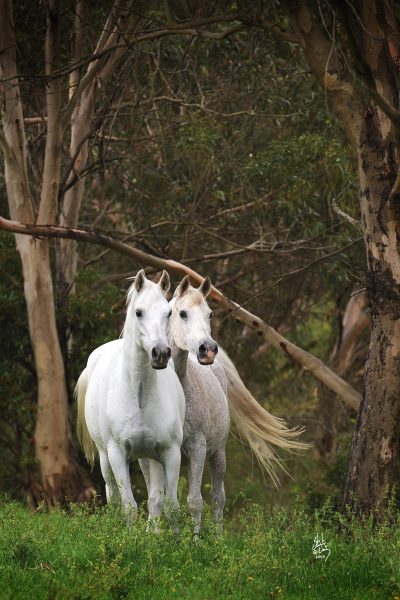
Karmaa-Kaborr-x-AN-Marieta-left-with-Mulawa-Chance-Ambition-x-Grojecca.
TABM: What were your breeding goals when you first started? Have they changed over the years?
The Farrells: For five decades, the principal mission of the Mulawa breeding programme has been to create and breed Arabian horses that:
- Are beautiful, correct and functional
- Have readily apparent presence, attitude and trainability
- Have wonderful temperaments; they must be kind and pleasant to be around
- Can excel both in the halter and performance competition
- Are capable of not only reproducing the superior qualities they possess, but also improving upon these characteristics in the next generation.
The Mulawa breeding philosophy remains purposefully centred around the creation of typically beautiful, world-class quality Arabian athletes capable of success and contribution at the elite level internationally.
TABM: Please share key moments that stand out in the early stages of your breeding programme?
The Farrells: The purchase of Ambition and his success as a sire influenced the positive direction of Mulawa more than any other. Every breeding decision made since his first sons and daughters began breeding has been based around enhancing his enduring influence with the best bloodlines available. Introducing stallions and mares from other influential bloodlines continues to teach us valuable lessons as breeders about maximising quality genetics, no matter the source, while remaining true to creating the authentic desert type of Arabian – noble, tenacious, intelligent and supremely useful – that reflects the Mulawa ideal.
TABM: When was it that you realised that you were a successful breeder? And what, in your opinion, defines a ‘breeder’?
The Farrells: For us, success as a breeder is reinforced every time a Mulawa-bred horse succeeds for a client, be it in the show-ring, pursuing a demanding equine sport such as endurance or racing, breeding successive generations of high quality progeny, or simply being an ideal all-around family horse. Having those clients return for another Mulawa-bred horse, sometimes decades later, reinforces our conviction that we are still on the right track, true to our original purpose of creating beautiful, useful and tractable Arabian horses.
A breeder is not only someone that remains true to their own convictions, principles and instincts, but has a comprehensive understanding of the Arabian ideal. The Arabian horse has a standard – a desert ideal that has withstood fad and fashion for 5000 years. That standard must always be clearly understood and adhered to if any breeding programme is to find long-term success. An Arabian horse that can ‘do’ something – capably, willingly and ambitiously – will always be a ‘beautiful’ and ‘typey’ Arabian.
We continue to have the greatest respect for those breeders around the world that remain true to their vision and to the authentic Arabian ideal.
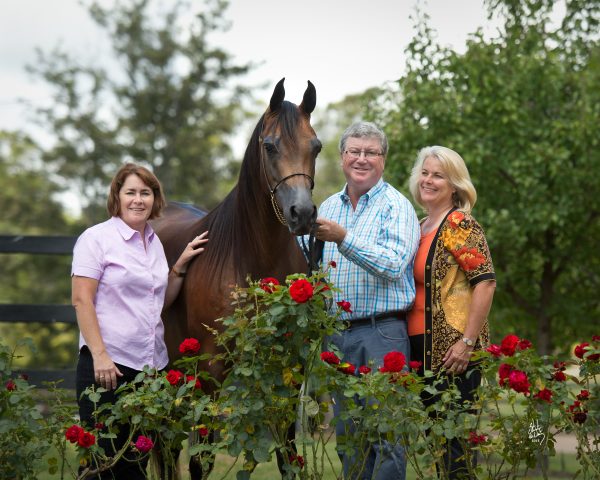
Farrell family / Jane / Always Valentine / Greg / Julie.
TABM: As a breeder, how do you feel about the showing world? Do you think that changes are needed to celebrate breeders more?
The Farrells: We have always enjoyed showing our horses – both in-hand and under saddle – and take great pleasure in seeing them succeed both for us and for the greater Mulawa community. Horse shows, like so many equine sporting competitions, can be incredibly rewarding, and can play a key role in maintaining interest and involvement with horses in the general population. While show results most certainly bolster the successful record of any breeding programme, they should never solely define the direction of the breeding programme. We do expect the Mulawa-bred Arabians to succeed as useful horses over the course of a lifetime but that success can, and most certainly does with great frequency, in a broad range of equine endeavours, oftentimes in delightfully unexpected ways.
TABM: Do you think that breeders are a dying breed, pardon the pun?
The Farrells: There is certainly a smaller number of breeders around the world than when Mulawa began breeding back in the 1970s. There is, however, still a great diversity of dedicated breeders in the international community committed to the breed. Quantity does not necessarily define quality. It is the responsibility of all breeders to work together to ensure the Arabian breed has a bright future, and will still have relevance for another 5000 years.
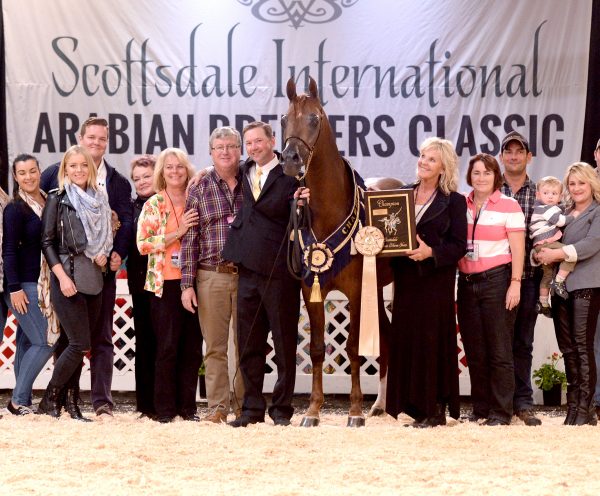
The whole Farrell family with Vangelis MI in Scottsdale this February, where he went unanimous Junior Male International Champion. Credit Osteen-Schatzberg.
TABM: Do you think that breeders and dedicated breeding programmes still have a place in the world today?
The Farrells: Breeders have always been the heart and soul of the Arabian horse world. It is their understanding of the authentic breed ideal, and their steadfast commitment to that ancient standard, that has kept the Arabian community on track for centuries. A world without breeders is a world without horses. Like a heaven without the same, it is a world in which we would never wish to live…
TABM: Over the years, what have been your key successes, perhaps the ones that define your farm?
The Farrells: Utility plus beauty equals the Arabian ideal. That has defined the Mulawa Arabian for almost half a century. That ‘Mulawa’ look is recognisable in all our horses. We would like to think those same ‘MI’ horses would look perfectly at home in the desert homeland, doing what the noble breed has done for millennia.
TABM: And finally, what is next for you and your breeding programme?
The Farrells: We look forward to continuing to create world-class quality Arabians – beautiful, versatile athletes – that influence the breed positively and progressively wherever they may find themselves in the world.
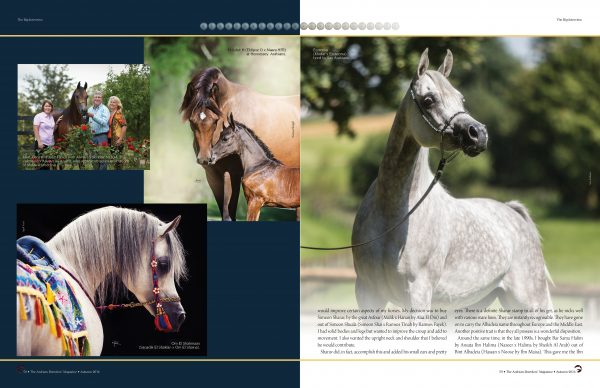
First printed in The Arabian Breeders’ Magazine Volume I Issue I September 2016. To enjoy further content such as this, please visit The Arabian Magazine Shop.
